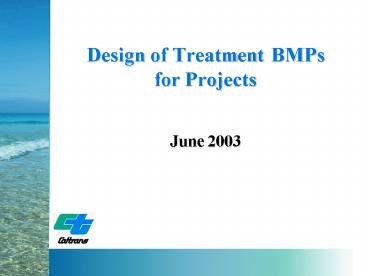Design of Treatment BMPs for Projects - PowerPoint PPT Presentation
1 / 18
Title:
Design of Treatment BMPs for Projects
Description:
Outlet Protection/Velocity Dissipation Devices. Slope/Surface Protection Systems ... Step 1: Gather data on tributary area and site characteristics ... – PowerPoint PPT presentation
Number of Views:43
Avg rating:3.0/5.0
Title: Design of Treatment BMPs for Projects
1
Design of Treatment BMPs for Projects
- June 2003
2
Course Objectives
Introduction
- To provide direction/guidance for designing
Treatment BMPs in accordance with the Project
Planning and Design Guide (PPDG) - To provide design exercises for most common types
of Treatment BMPs - workgroup exercises
- solved examples
3
Course Overview
Introduction
- This course is very hands-on for design
principles for each type of Treatment BMP - Students are expected to have previously attended
PPDG training and have a working knowledge of
Hydraulics.
4
Initial Assessment Quiz
Introduction
- Please take 10 minutes to complete the Initial
Assessment Quiz - Provide your answers in pencil (blue or black ink
OK) on the PRE side of the Scantron card
5
Regulatory Framework
Introduction
- Clean Water Act (CWA) was enacted to restore and
maintain the integrity of the waters of the
United States - Under the CWA, the National Pollutant Discharge
Elimination System (NPDES) Permits were
established - Caltrans has a statewide NPDES permit which
covers both storm water and non-storm water
runoff from both maintenance and operational
activities and construction sites
6
Caltrans Storm Water Management Plan (SWMP)
Introduction
- Caltrans Permit requires the Department to
implement and maintain an effective SWMP - Caltrans SWMP includes
- Procedures and practices to manage storm water
quality - Descriptions of major program elements
- Key implementation responsibilities and schedules
- A list of the approved BMPs
7
Pollutants of Concern
Introduction
- Total Suspended Solids
- Nutrients
- Pesticides
- Particulate Metals
- Dissolved Metals
- Pathogens
- Litter
- Biochemical Oxygen Demand
- Total Dissolved Solids
PPDG Table 2-2, Page 2-7
8
Caltrans Approved BMPs
Introduction
- Caltrans SWMP identifies permanent and temporary
BMPs that have been approved for statewide
application - Four categories
- Design Pollution Prevention BMPs
- Treatment BMPs - this course
- Construction Site BMPs
- Maintenance BMPs
9
Design Pollution Prevention BMPs
Introduction
- Design Pollution Prevention BMPs are
- Permanent Source Control BMPs to improve storm
water quality after construction is complete - Incorporated into all project designs
10
Design Pollution Prevention BMPs
Introduction
PPDG Table A-1, Page A-1
11
Design Pollution Prevention BMPs versus Treatment
Control BMPs
- Design Pollution BMPs are source control BMPs
used to prevent pollutants from entering into
Storm Water discharges - Treatment BMPs are used to remove pollutants from
storm water discharges. Usually provided in
series with Design Pollution Prevention BMPs.
12
Approved Treatment Control BMPs
Introduction
- Six types of treatment BMPs have been identified
in the SWMP - Biofiltration strips/swales
- Infiltration basins
- Detention devices
- Traction sand traps
- Dry weather flow diversion
- Gross Solids Removal Devices (GSRDs)
13
Treatment Control BMPs
Introduction
- The approved treatment BMPs are considered to be
technically and fiscally feasible. - Caltrans has found these BMPs to be
constructable, maintainable, and effective at
removing pollutants.
14
Treatment BMPDecision Tree T-1
Introduction
PPDG Page E-25
15
Checklist T-1 Part 1 Questions
Introduction
PPDG Page E-26
16
Site Specific Determination of Feasibility
Introduction
- Compliance with Siting Criteria
- Technical feasibility
- Regulatory, Legal and Institutional constraints
17
Feasibility Assessment
Introduction
- Step 1 Gather data on tributary area and site
characteristics - Step 2 Determine Water Quality Volume (WQV),
Water Quality Flow (WQF), and Design Storm that
must be treated/conveyed - Step 3 Calculate size of proposed BMP
- Step 4 Evaluate treatment BMP operational and
siting considerations - Step 5 Document process in Storm Water Data
Report (see PPDG Appendix E)
18
Questions































